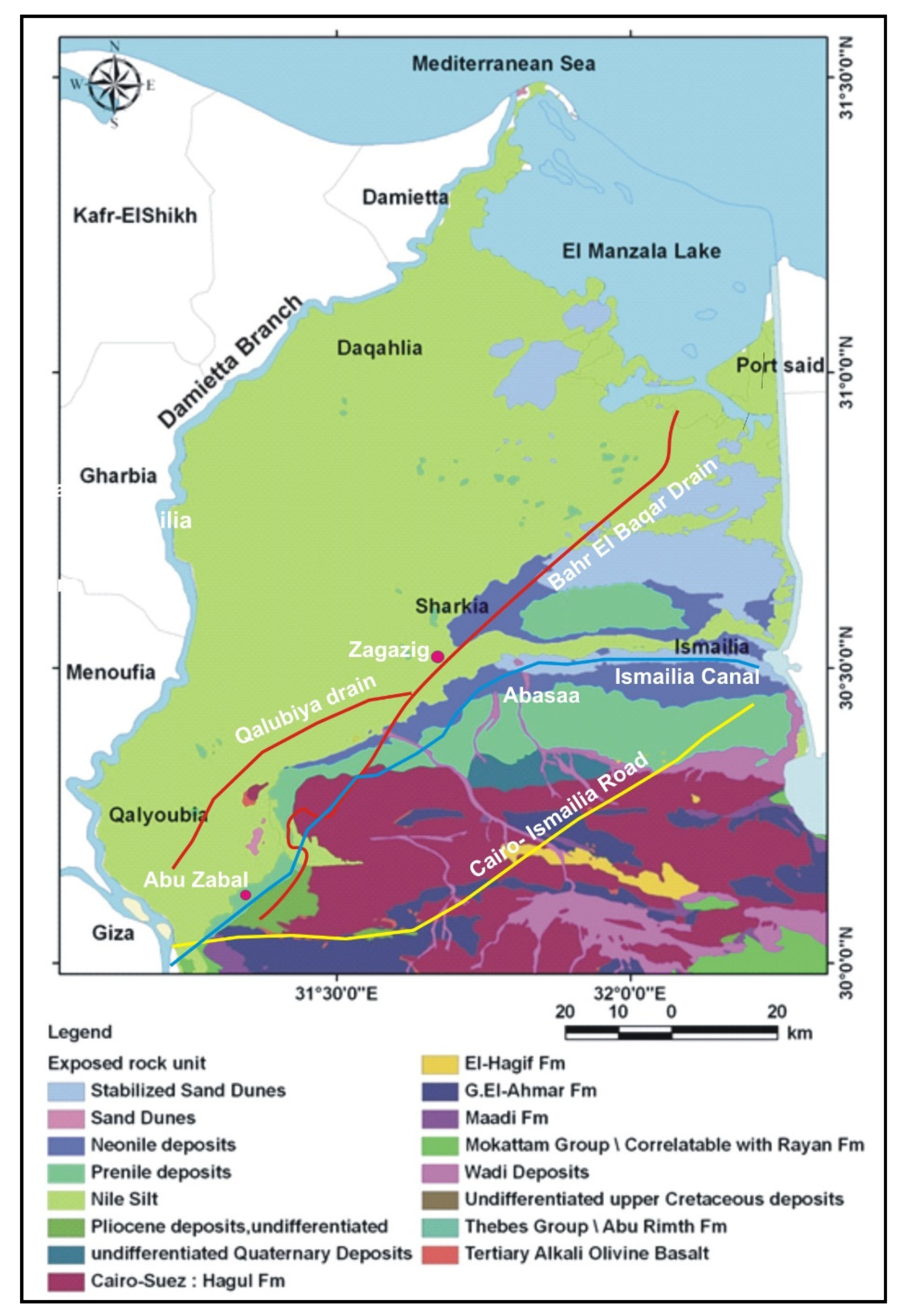Assessing the Impact of Lining Polluted Streams on Groundwater Quality: A Case Study of the Eastern Nile Delta Aquifer, Egypt
Abstract
:1. Introduction
2. Study Area Description
3. Mathematical Model
3.1. Model Geometry
3.2. Model Boundary Conditions
3.3. Hydraulic Parameters
3.4. Model Calibration
4. Model Results
4.1. Groundwater Flow in the ENDA
4.2. Solute Transport in the ENDA
4.3. Impact of Increasing Abstraction Rates on Groundwater Quality in the ENDA
5. Protecting the Groundwater in the ENDA
6. Cost Analysis for the Lining Materials Used
7. Discussion
8. Conclusions
Author Contributions
Funding
Institutional Review Board Statement
Informed Consent Statement
Data Availability Statement
Acknowledgments
Conflicts of Interest
References
- Margat, J.; Gun, J.v.d. Groundwater around the World; CRC Press/Balkema: Boca Raton, FL, USA, 2013. [Google Scholar]
- Smith, M.; Cross, K.; Paden, M.; Laban, P. Spring—Managing Groundwater Sustainability; IUCN: Gland, Switzerland, 2016. [Google Scholar]
- Gleeson, T.; Befus, K.M.; Jasechko, S.; Luijendijk, E.; Cardendas, M.B. The global volume and distribution of modern groundwater. Nat. Geosci. 2016, 9, 161–167. [Google Scholar] [CrossRef]
- Abdel-Shafy, H.; Kamel, A.H. Groundwater in Egypt issue: Resources, location, amount, contamination, protection, renewal, future overview. Egypt. J. Chem. 2016, 59, 321–362. [Google Scholar]
- Negm, A.M.; Sakr, S.; Abd-Elaty, I.; Abd-Elhamid, H.F. An Overview of Groundwater Resources in Nile Delta Aquifer. The Handbook of Environmental Chemistry. In Groundwater in the Nile Delta; Negm, A., Ed.; Springer: Cham, Switzerland, 2018; Volume 73. [Google Scholar] [CrossRef]
- Molle, F.; Gaafar, I.; El-Agha, D.E.; Rap, E. Irrigation Efficiency and the Nile Delta Water Balance, Water and salt management in the Nile Delta: Report No.9. Int. Water Manag. Inst. Aust. Cent. Int. Agric. Res. 2016. [Google Scholar] [CrossRef]
- Abd-Elaty, I.; Javadi, A.; Abd-Elhamid, H. Management of saltwater intrusion in coastal aquifers using different wells systems: A case study of the Nile Delta aquifer in Egypt. Hydrogeol. J. 2021. [Google Scholar] [CrossRef]
- Smith, A.J.; Pollock, D.W.; Palmer, D. Groundwater interaction with surface drains in the Ord River Irrigation Area, northern Australia: Investigation by multiple methods. Hydrogeol. J. 2010, 18, 1235–1252. [Google Scholar] [CrossRef]
- El-Sayed, S.A.; Morsy, S.M.; Zakaria, K.M. Recharge sources and geochemical evolution of groundwater in the Quaternary aquifer at Atfih area, the northeastern Nile Valley, Egypt. J. Afr. Earth Sci. 2018, 142, 82–92. [Google Scholar] [CrossRef]
- Nofal, E.R.; Fekry, A.M.; Ahmed, M.H.; El-Kharakany, M.M. Groundwater: Extraction versus recharge; vulnerability assessment. Water Sci. 2018, 32, 287–300. [Google Scholar] [CrossRef] [Green Version]
- Bear, J. Hydraulics of Groundwater; McGraw-Hill: New York, NY, USA, 1979. [Google Scholar]
- JICA (Japan International Cooperation Agency). The Project for Drainage Water Quality Control for Irrigation in Middle Nile Delta in the Arab Republic of Egypt, Report; JICA: Tsukuba-shi, Ibaraki-ken, Japan, 2016. [Google Scholar]
- Arnous, M.O.; El-Rayes, A.E. An Integrated GIS and Hydrochemical Approach to Assess Groundwater Contamination in West Ismailia Area, Egypt. Arab. J. Geosci. 2013, 6, 2829–2842. [Google Scholar] [CrossRef]
- Abd-Elhamid, H.F.; Abdelaal, G.M.; Abd-Elaty, I.; Said, A.M. Evaluation of groundwater vulnerability to seepage from open drains considering different pumping schemes in unconfined aquifers. In Proceedings of the Twenty-First International Water Technology Conference, IWTC21, Ismailia, Egypt, 28–29 June 2018; pp. 358–364. [Google Scholar]
- Blanco, M.; Castillo, F.; Soriano, J.; Noval, A.M.; Touze-Foltz, N.; Pargada, L.; Rico, G.; Aguiar, E. Comparative Study of Three Different Kinds of Geomembranes (PVC-P, HDPE, EPDM) Used in the Waterproofing of Reservoirs; Eurogeo: Valencia, Spain, 2012; pp. 46–54. [Google Scholar]
- Khair, A.; Nalluri, C.; Kilkenny, W.M. Soil-cement tiles for lining irrigation canals. Irrig. Drain. Syst. 1991, 5, 151–163. [Google Scholar] [CrossRef]
- Park, J.H.; Rim, J.T.; Min, T.I. Thermoplastic Geomembranes for Water Barriers. In Frontiers of Polymers and Advanced Materials; Prasad, P.N., Ed.; Springer: Boston, MA, USA, 1994; pp. 411–421. [Google Scholar]
- Schneider, S.; Mallants, D.; Jacques, D. Determining hydraulic properties of concrete and mortar by inverse modelling. MRS Proc. 2012, 1475, 60. [Google Scholar] [CrossRef] [Green Version]
- Ören, A.H.; Kaya, A.; Kayalar, A.Ş. Hydraulic conductivity of zeolite–bentonite mixtures in comparison with sand–bentonite mixtures. Can. Geotech. J. 2011, 48, 1343–1353. [Google Scholar] [CrossRef]
- Abd-Elaty, I.; Zelenakova, M.; Straface, S.; Vranayová, Z.; Abu-hashim, M. Integrated Modelling for Groundwater Contamination from Polluted Streams Using New Protection Process Techniques. Water 2019, 11, 2321. [Google Scholar] [CrossRef] [Green Version]
- Abd-Elaty, I.; Pugliese, L.; Zelenakova, M.; Mesaros, P.; Shinawi, A.E. Simulation-Based Solutions Reducing Soil and Groundwater Contamination from Fertilizers in Arid and Semi-Arid Regions: Case Study the Eastern Nile Delta, Egypt. Int. J. Environ. Res. Public Health 2020, 17, 9373. [Google Scholar] [CrossRef]
- El Haddad, I.M. Hydrogeological Studies and Their Environmental Impact on Future Management and Sustainable Development of the New Communities and Their Surroundings, East of the Nile Delta. Ph.D. Thesis, University of Mansoura, Mansoura, Egypt, 2002. [Google Scholar]
- Saad, A.K. Environmental Hydrogeologic Impacts Groundwater Withdrawal in the Eastern Nile Delta Region with Emphasis on Groundwater Pollution Potential. Ph.D. Thesis, Institute of Environmental Studies, Ain Shams University, Cairo, Egypt, 1997; 232p. [Google Scholar]
- Karaman, H.G. Identifying uncertainty of the mean of some water quality variables along water quality monitoring network of Bahr El Baqar drain. Water Sci. 2013, 27, 48–56. [Google Scholar] [CrossRef] [Green Version]
- Taha, A.A.; El Mahmoudi, A.E.; El-Haddad, I.M. Pollution sources and related environmental impacts in the new communities southeast Nile Delta, Egypt. Emir. J. Eng. Res. 2004, 9, 35–49. [Google Scholar]
- CONOCO. Geological Map of Egypt, Scale 1: 500,000, Nile Delta, NH-36; Egyptian General Petroleum Corporation: Cairo, Egypt, 1987. [Google Scholar]
- Abd-Elhamid, H.F.; Javadi, A.; Abdelaty, I.; Sherif, M. Simulation of seawater intrusion in the Nile Delta aquifer under the conditions of climate change. Hydrol. Res. 2016, 47, 1198–1210. [Google Scholar] [CrossRef]
- Morsy, W.S. Environmental Management to Groundwater Resources for Nile Delta Region. Ph.D. Thesis, Faculty of Engineering, Cairo University, Cairo, Egypt, 2009. [Google Scholar]
- Abd-Elaty, I.; Sallam, G.A.; Strafacec, S.; Scozzari, A. Effects of climate change on the design of subsurface drainage systems in coastal aquifers in arid/semi-arid regions: Case study of the Nile delta. Sci. Total Environ. J. 2019, 672, 283–295. [Google Scholar] [CrossRef] [PubMed]
- Abdelaty, I.M.; Abd-Elhamid, H.F.; Fahmy MRAbdelaal, G.M. Study Impact of Climate Change and Other on Groundwater System in Nile Delta Aquifer. Egypt. J. Eng. Sci. Technol. Zagazig Univ. Fac. Eng. 2014, 174, 2061–2079. [Google Scholar]
- MWRI. Adaptation to Climate Change in the Nile Delta through Integrated Coastal Zone Management; Ministry of Water Resources and Irrigation: Cairo, Egypt, 2013. [Google Scholar]
- Gado, T.A. Statistical characteristics of extream rainfall events in Egypt. In Proceedings of the Twentieth International Water Technology Conference, IWTC20, Hurghada, Egypt, 18–20 May 2017; pp. 645–653. [Google Scholar]
- FAO, Food and Agriculture Organization of the United Nations. High Dam Soil Survey Project; Ministry of Agriculture: Cairo, Egypt, 1966; Volume 3, pp. 1–348. [Google Scholar]
- McDonald, M.G.; Harbaugh, A.W. Techniques of Water-Resources Investigations 06-A1. In A Modular Three-Dimensional Finite-Difference Ground-Water Flow Model; US Geological Survey: Reston, VA, USA, 1988. [Google Scholar]
- Javandel, I.; Doughty, C.; Tsang, C.-F. Groundwater Transport: Handbook of Mathematical Models. American Geophysical Union. Water Resour. Monogr. 1984. [Google Scholar] [CrossRef]
- Ezzeldin, M.; El-Alfy, K.; Abdelgawad, H.A.; Abd-Elmaboud, M. Comparison between Structured and Unstructured MODFLOW for Simulating Groundwater Flow in Three-Dimensional Multilayer Quaternary Aquifer of East Nile Delta, Egypt. Hydrol. Curr. Res. 2018, 9, 1000297. [Google Scholar] [CrossRef]
- El-Arabi, M. Environmental Impact of New Settlements in Groundwater in a Region in the Nile Delta. Master’s Thesis, Faculty of Engineering, Zagazig University, Zagazig, Egypt, 2007. [Google Scholar]
- RIGW (Research Institute for Groundwater). Projected of the Safe Yield Study for Groundwater Aquifer in the Nile Delta and Upper Egypt. Part 1; Ministry of Irrigation, Academy of Scientific Research and Technology, and Organization of Atomic Energy: Cairo, Egypt, 1980. [Google Scholar]
- Abd-Elaty, I.; Zeleňáková, M.; Krajníková, K.; Abd-Elhamid, H.F. Analytical Solution of Saltwater Intrusion in Costal Aquifers Considering Climate Changes and Different Boundary Conditions. Water 2021, 13, 995. [Google Scholar] [CrossRef]
- Zelenakova, M.; Hlavinek, P.; Negm, A.M. Management of Water Quality and Quantity; Springer International Publishing Ag: Cham, Switzerland, 2020. [Google Scholar]
- Negm, A.M.; Romanescu, G.; Zelenakova, M. Water Resources Management in Balkan Countries; Springer International Publishing Ag: Cham, Switzerland, 2020. [Google Scholar]
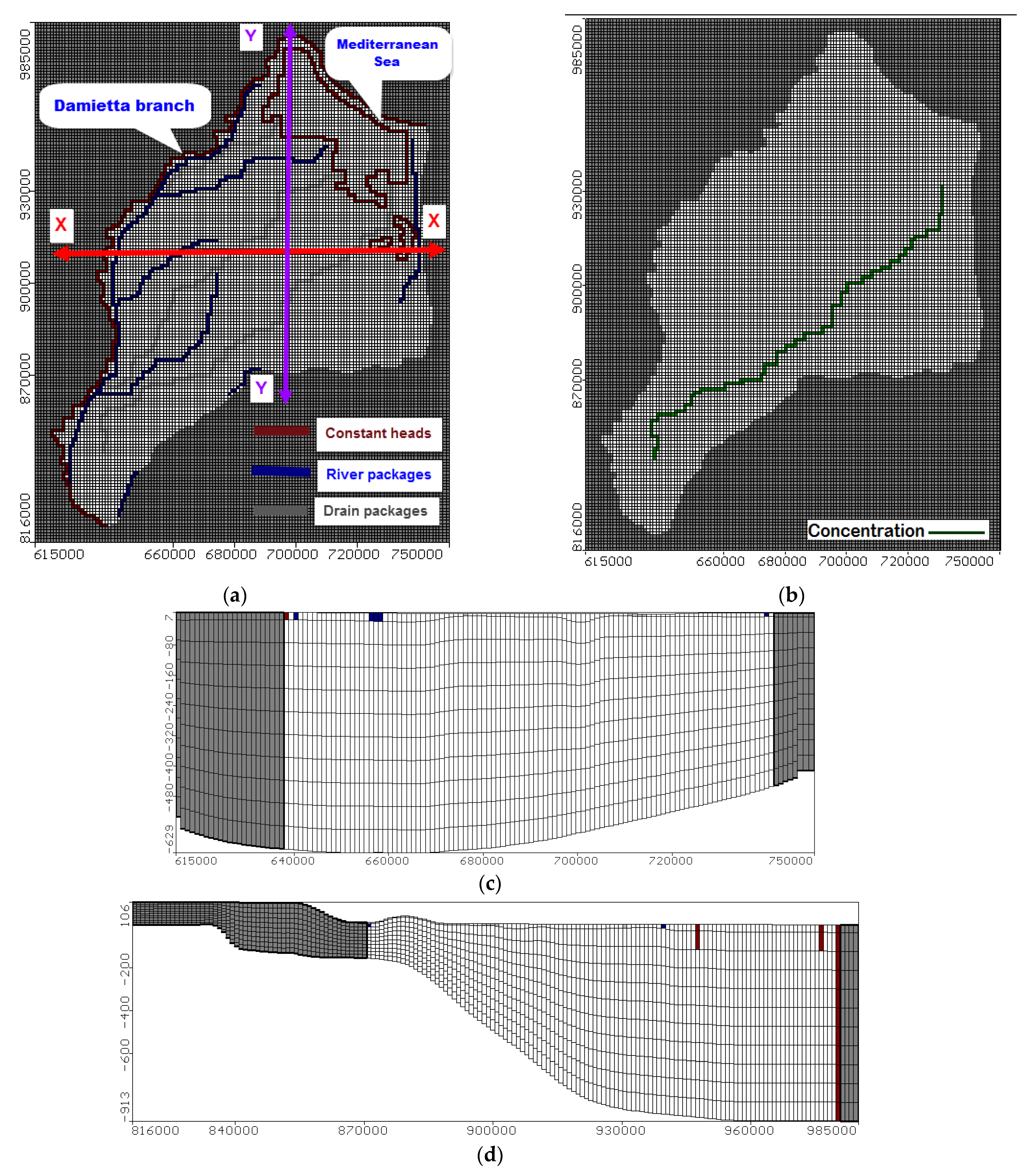
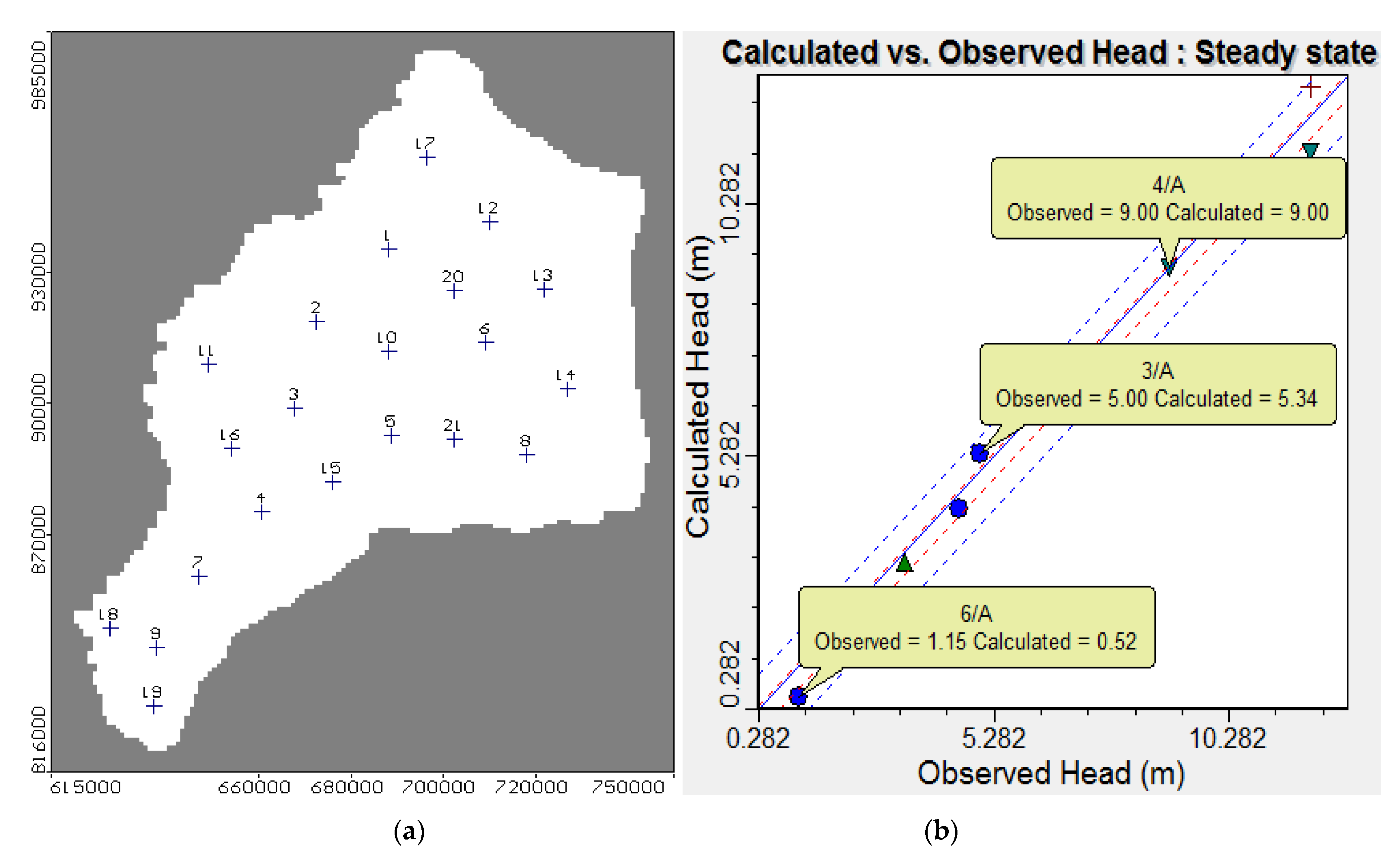
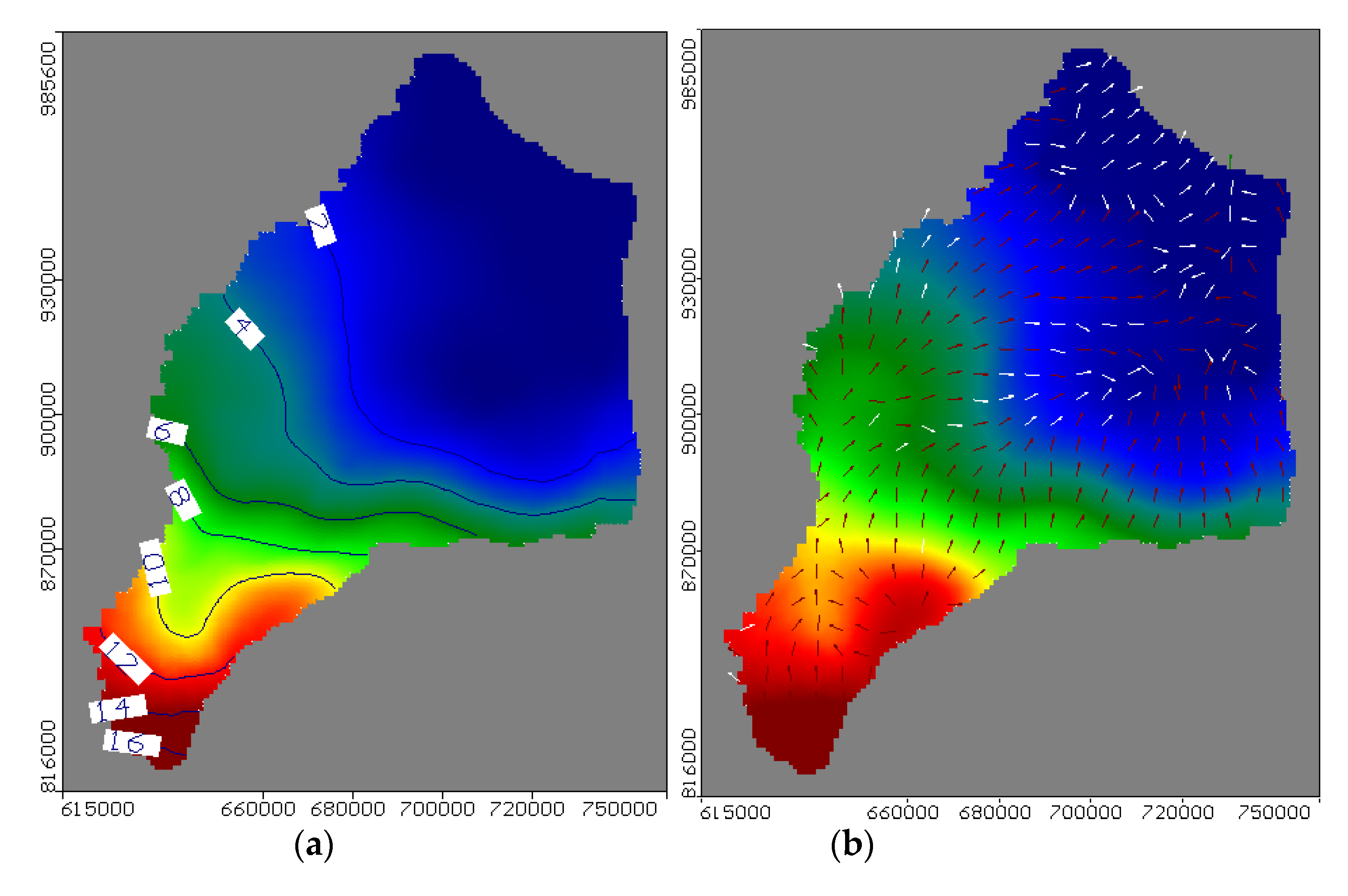
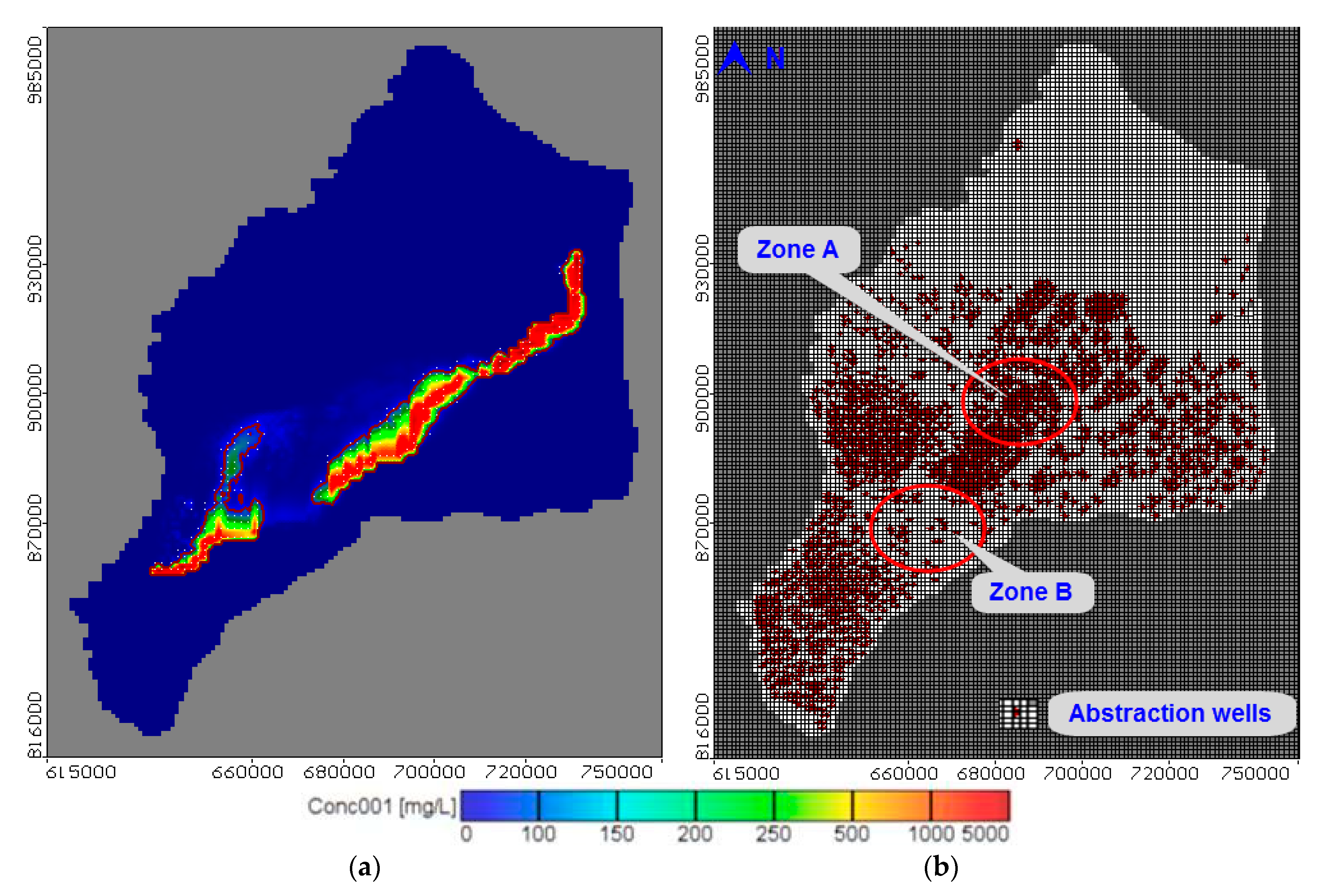

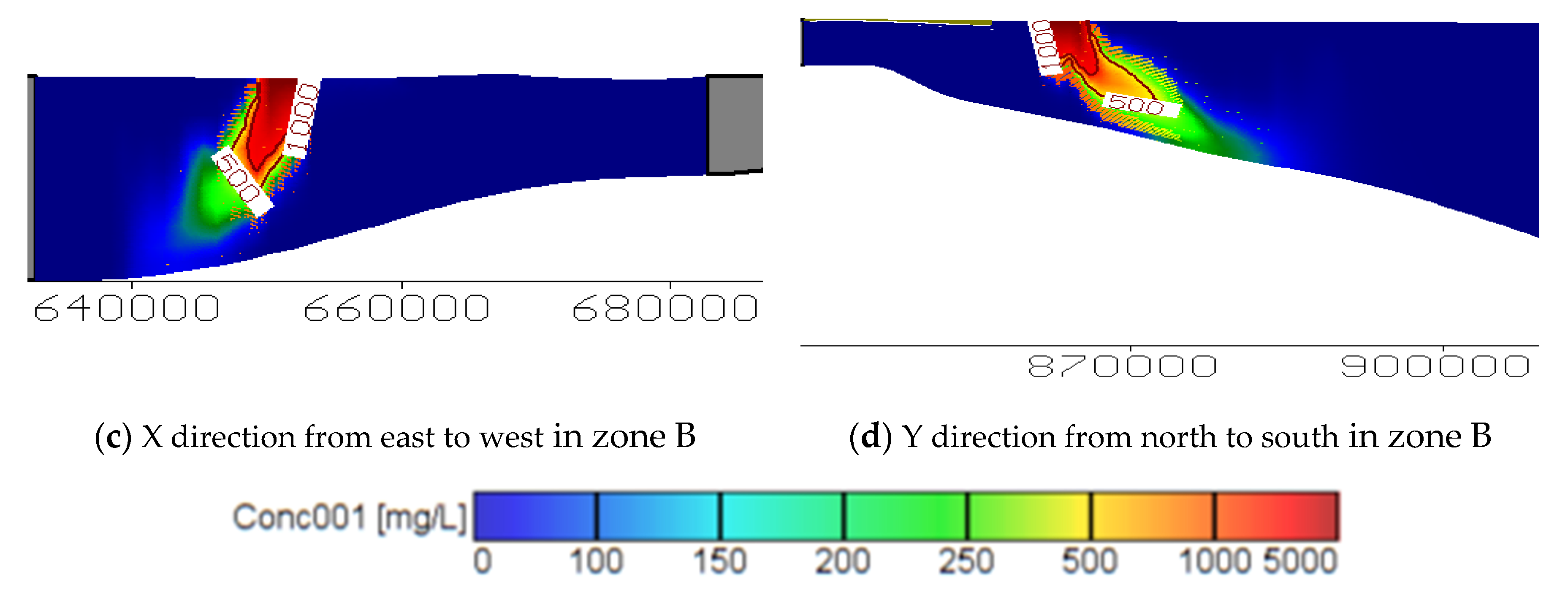
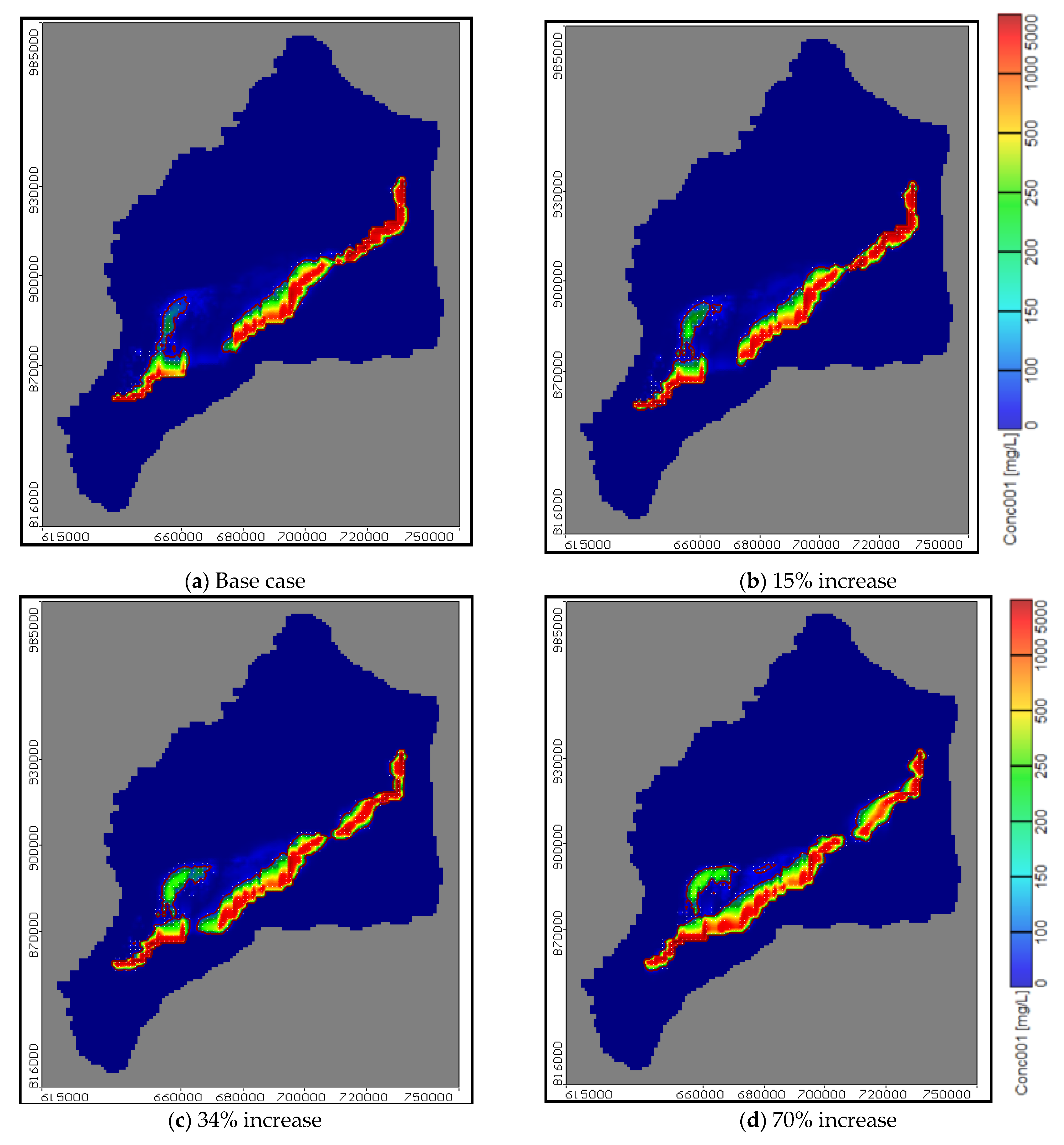

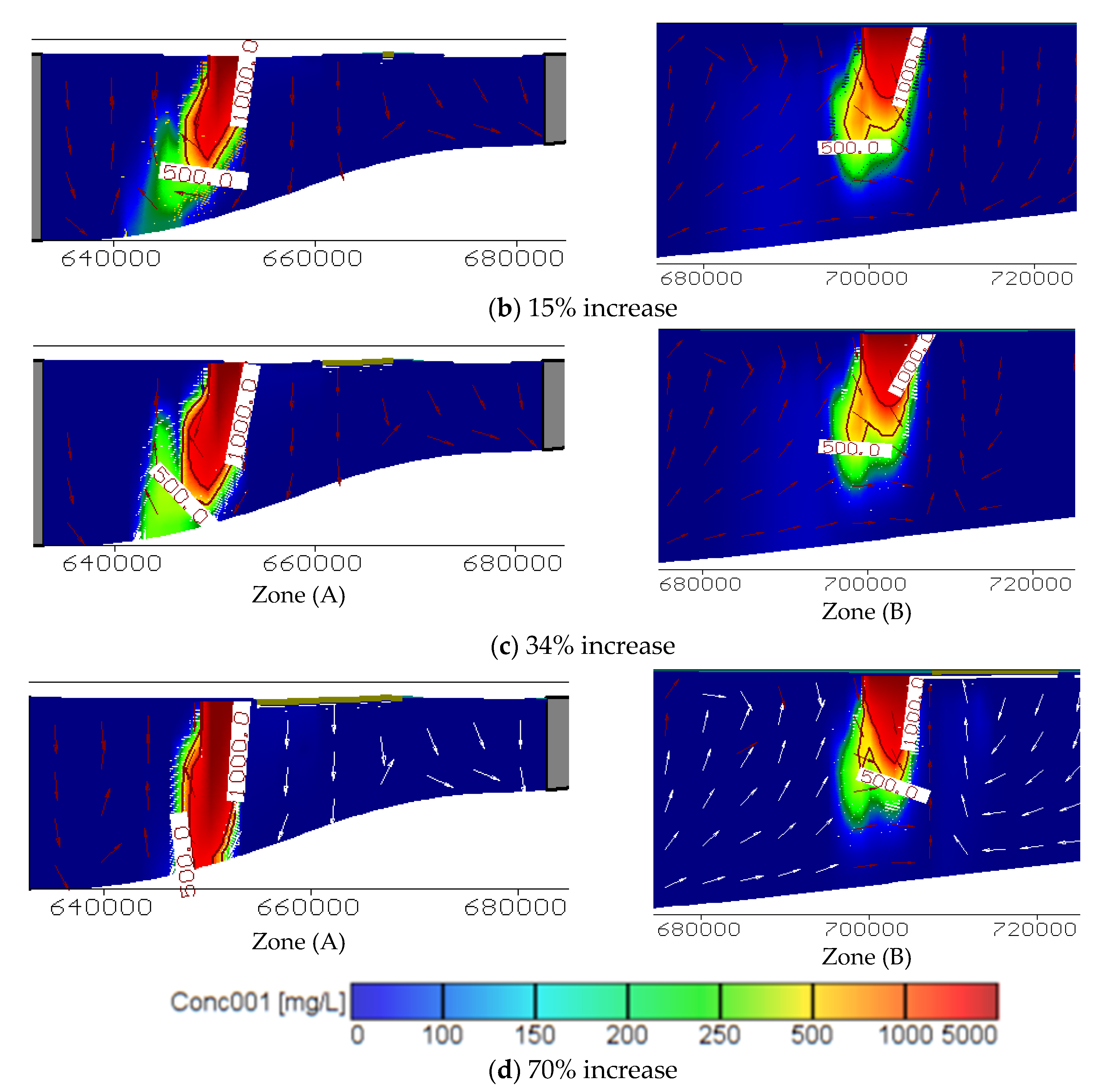
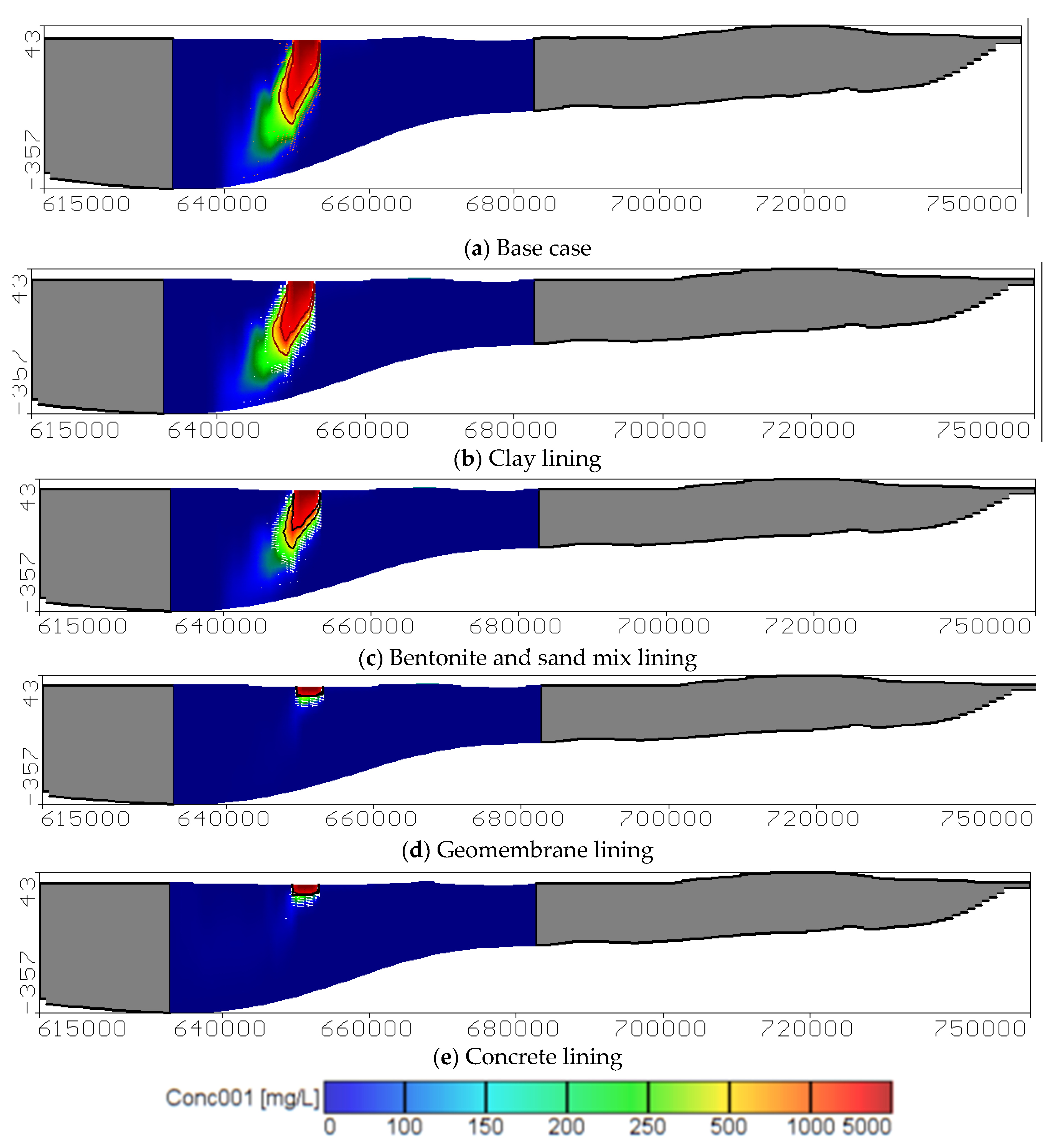

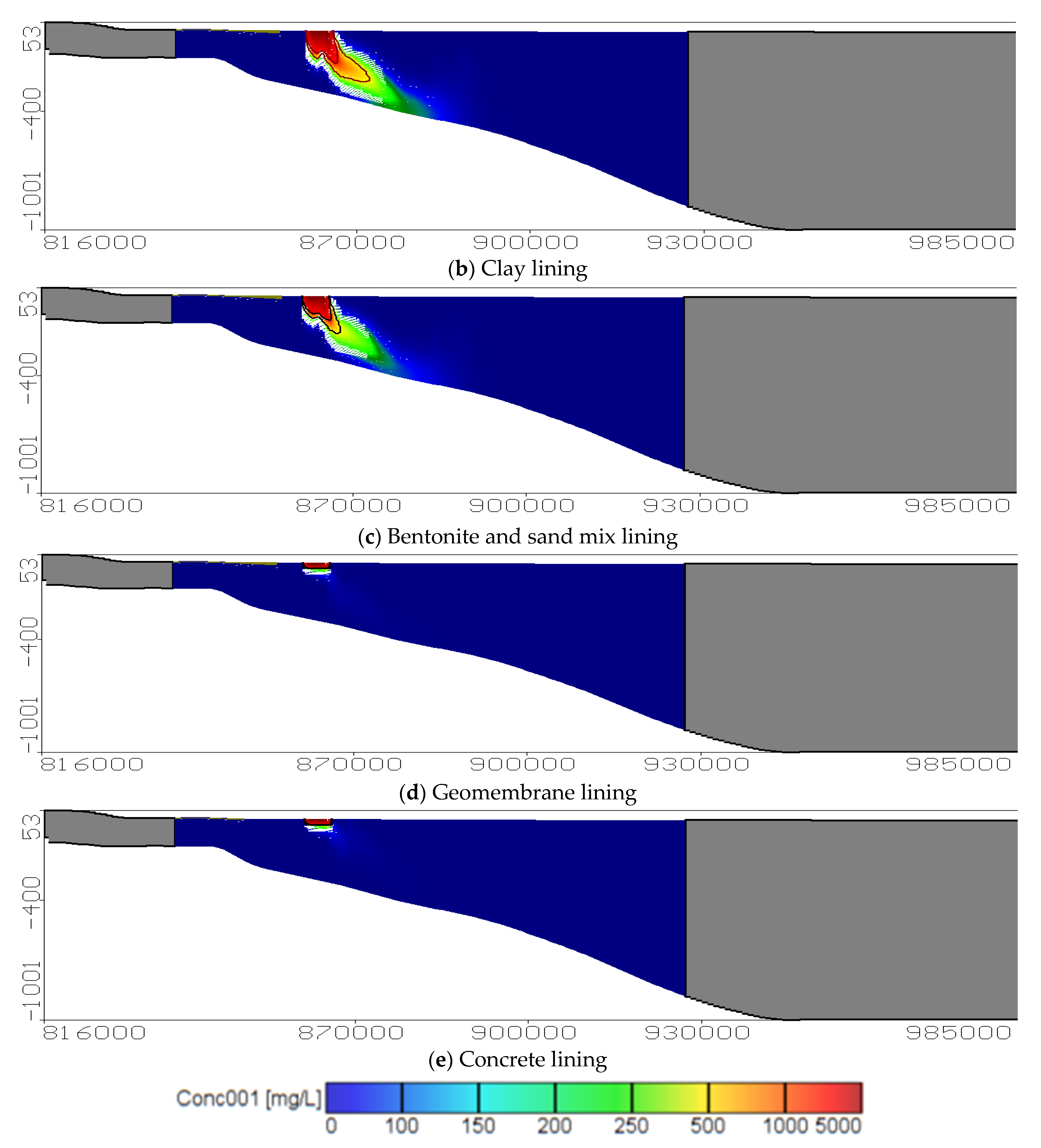
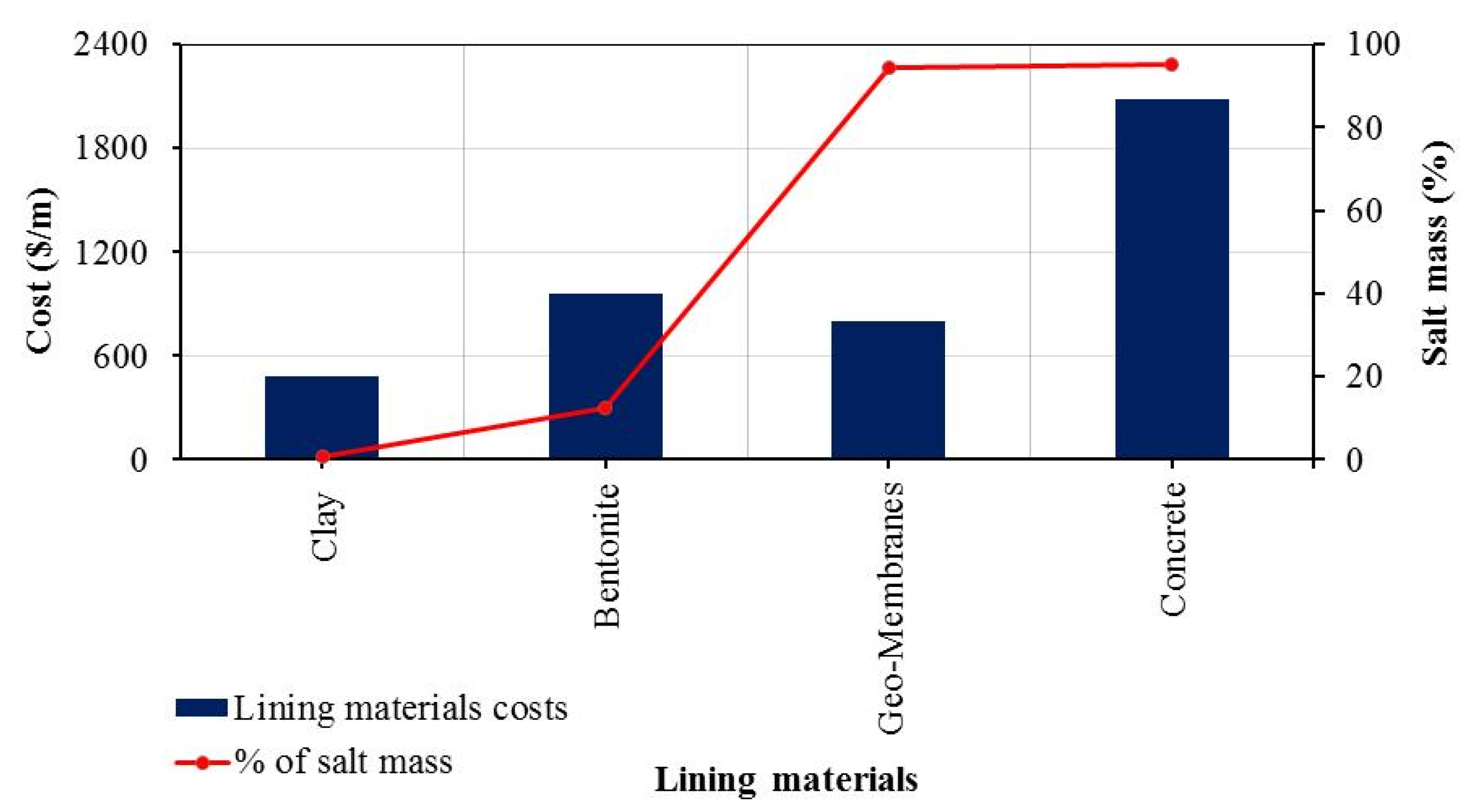
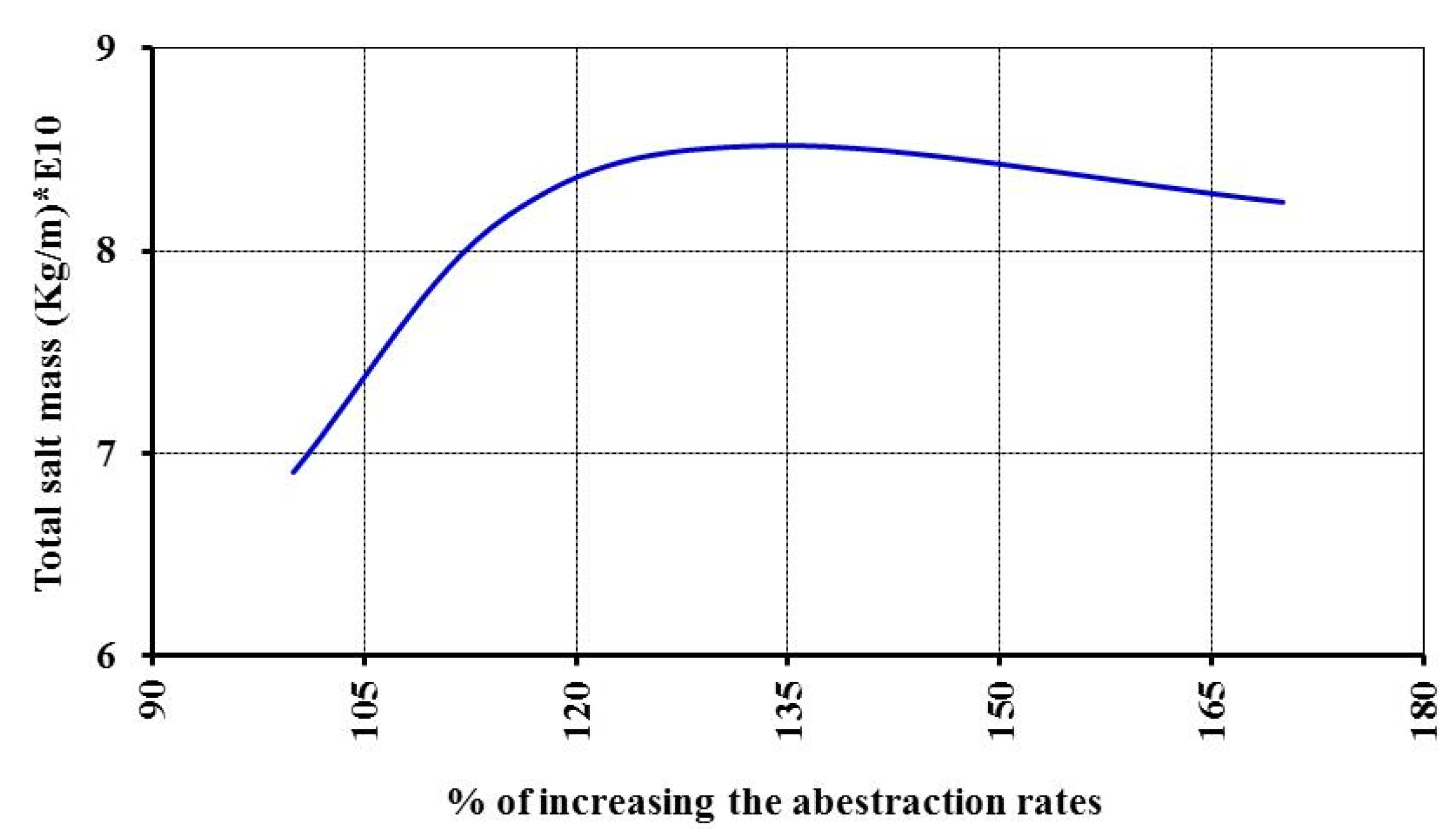
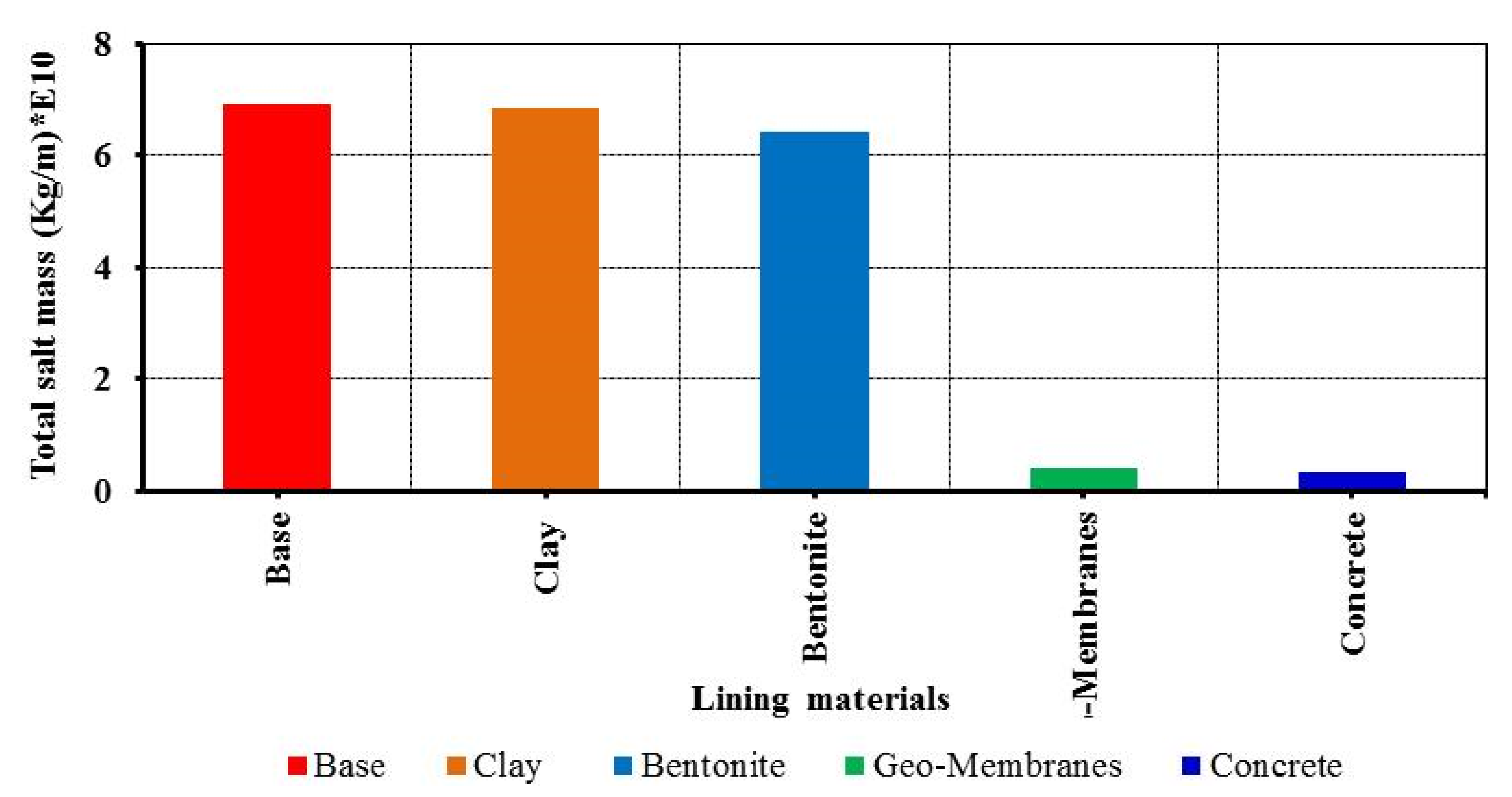
| Water Body | Total Length (km) | Bottom Width (m) | Mean Depth (m) | Surface Water Level Range |
|---|---|---|---|---|
| Damietta branch | 245 | 0–200 | 6 | 16–1.0 |
| El Rayah El Tawfiky | 63 | 10–26 | 5 | 16–0.5 |
| Ismailia canal | 136 | 10–30 | 5 | 16–0.0 |
| El Sharkaweya Canal | 32 | 7–10 | 5 | 16.5–13.0 |
| El Basoseya Canal | 24 | 5–10 | 5 | 16–12.0 |
| Suez Canal | 173 | - | 16 | - |
| El Manzala Lake (area) Km2 | 1500 | - | 1.2 | 1–0.0 |
| Bahr El Baqar drain | 85 | 100–200 | 5 | - |
| Bahr Hadous drain | 50 | 5–40 | 5 | - |
| El Serw drain | 30 | 5–10 | 5 | - |
| Layer No. | Layer Type | Hydraulic Conductivity (m/Day) | Storage Coefficient | Specific Yield | Effective Porosity | |
|---|---|---|---|---|---|---|
| Kh | Kv | SS (-) | Sy (1/m) | neff (%) | ||
| 1 | Clay | 0.10–0.25 | 0.01–0.025 | 10−3 | 0.10 | 50–0 |
| From 2 to 5 | Fine sand with lenses of clay | 5–20 | 0.5–2 | 5 × 10−3 | 0.15 | 30 |
| From 6 to 9 | Coarse sand quaternary | 20–75 | 2–7.5 | 2.5 × 10−3 | 0.18 | 25 |
| From 10 and 11 | Graded sand and gravel | 75–100 | 7.5–10 | 5 × 10−4 | 0.20 | 20 |
| Scenarios No | Year | Increasing Rate (%) | Abstraction Rate (m3) | Total Mass After (kg) |
|---|---|---|---|---|
| Base case study | 2010 | 100 | 3.480 × 106 | 6.907 × 1010 |
| First scenario | 2025 | 115 | 4.002 × 106 | 8.165 × 1010 |
| Second scenario | 2040 | 134 | 4.663 × 106 | 8.519 × 1010 |
| Third scenario | 2060 | 170 | 5.916 × 106 | 8.239 × 1010 |
Publisher’s Note: MDPI stays neutral with regard to jurisdictional claims in published maps and institutional affiliations. |
© 2021 by the authors. Licensee MDPI, Basel, Switzerland. This article is an open access article distributed under the terms and conditions of the Creative Commons Attribution (CC BY) license (https://creativecommons.org/licenses/by/4.0/).
Share and Cite
Abd-Elaty, I.; Said, A.M.; Abdelaal, G.M.; Zeleňáková, M.; Jandora, J.; Abd-Elhamid, H.F. Assessing the Impact of Lining Polluted Streams on Groundwater Quality: A Case Study of the Eastern Nile Delta Aquifer, Egypt. Water 2021, 13, 1705. https://doi.org/10.3390/w13121705
Abd-Elaty I, Said AM, Abdelaal GM, Zeleňáková M, Jandora J, Abd-Elhamid HF. Assessing the Impact of Lining Polluted Streams on Groundwater Quality: A Case Study of the Eastern Nile Delta Aquifer, Egypt. Water. 2021; 13(12):1705. https://doi.org/10.3390/w13121705
Chicago/Turabian StyleAbd-Elaty, Ismail, Abdelrahman M. Said, Gamal M. Abdelaal, Martina Zeleňáková, Jan Jandora, and Hany F. Abd-Elhamid. 2021. "Assessing the Impact of Lining Polluted Streams on Groundwater Quality: A Case Study of the Eastern Nile Delta Aquifer, Egypt" Water 13, no. 12: 1705. https://doi.org/10.3390/w13121705





